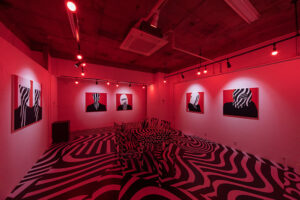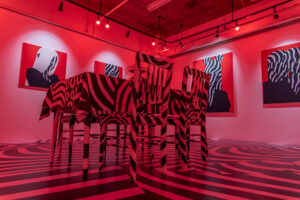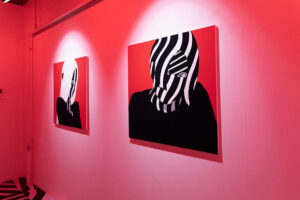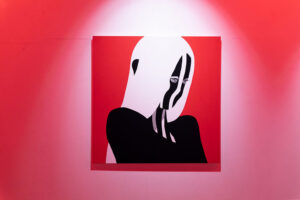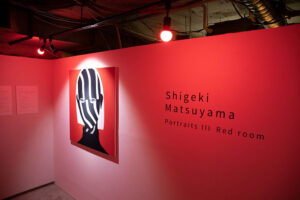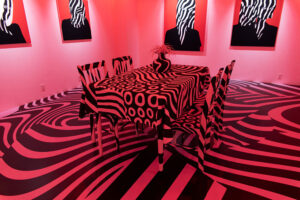松山しげき|Shigeki Matsuyama “Portraits III Red room”
松山しげき|Shigeki Matsuyama “Portraits III Red room”
2022年04月23日(土)-2022年05月01日(日)
ロイドワークスギャラリー
このたびロイドワークスギャラリーでは、海外でも大変な人気を集めている松山しげきのポートレートシリーズの新作タブローを発表致します。
第一次大戦にも使用されたダズル迷彩を用いて、インターネットの匿名性や情報の不確かさを表現した「現代人の肖像画」を描く松山しげき。
これまでの展覧会とは異なり、本展ではポートレートシリーズをインスタレーションとして見せる試みを行なっています。
作品をSNSなどで画面越しに見るだけでなく、実際に会場に足を運んで作品の中に入り込む感覚でご覧いただけると幸いです。
roidworksgallery is pleased to announce Shigeki Matsuyama’s solo exhibition “Portraits III Red room”.
Matsuyama’s portrait paintings represent “portraits of people living in contemporary society” who struggle with the ambiguity of information and anonymity by employing dazzle camouflage in his paintings. These iconic art pieces have recently been eliciting a lot of attention from international art audiences.
Unlike previous exhibitions, Matsuyama attempts to organize an installation consisting of his newly painted portraiture in this exhibition.
Apart from showing exhibition photos on social networking services, we welcome you to visit our gallery and hope you enjoy this exhibition by entering an artwork by Matsuyama.
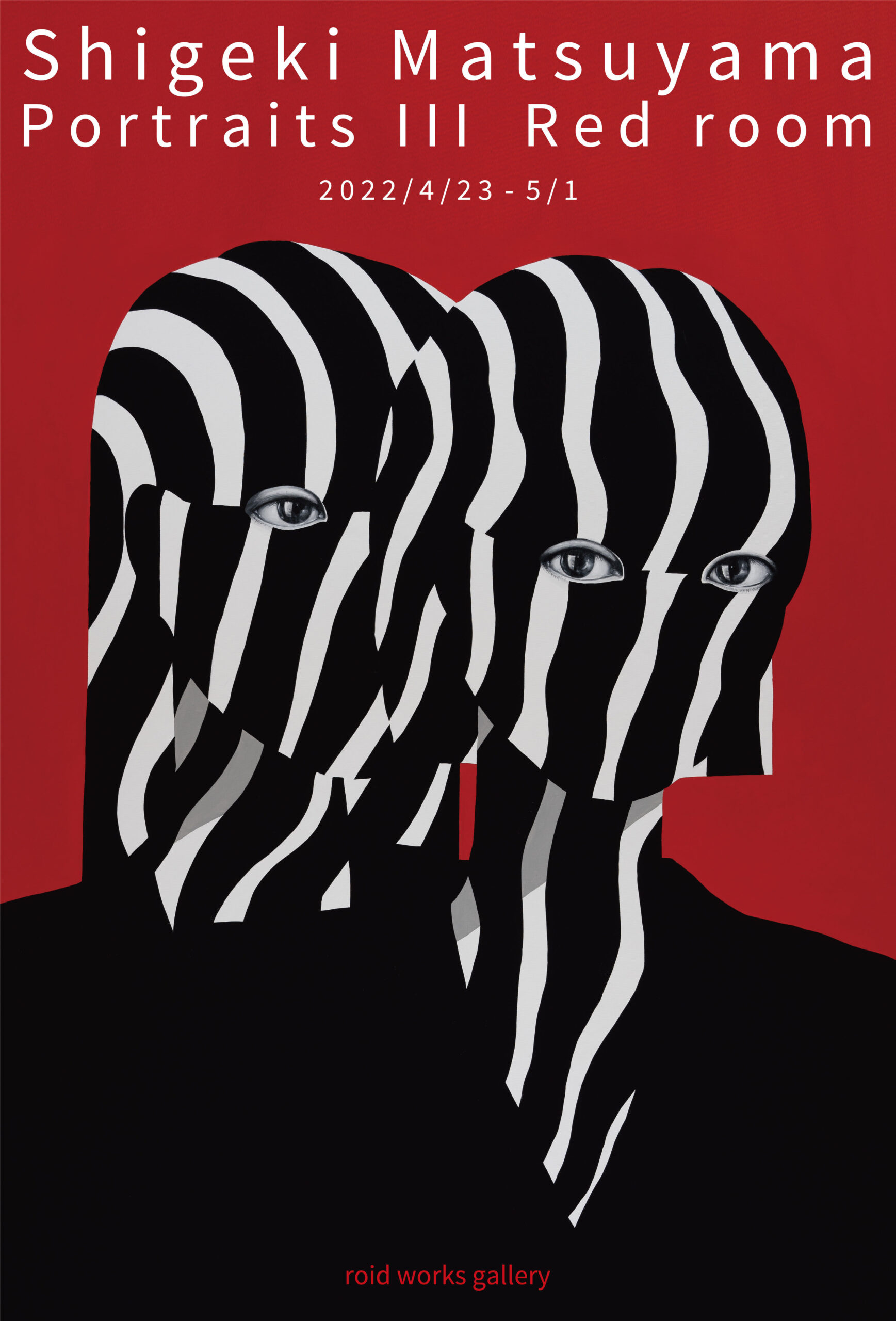
Shigeki Matsuyama
“Portraits III Red room”
2022年 4月23日(土)-5月1日(日)
(会期中無休)
営業時間:12:00-19:00 (最終日は18:00まで)
会場:ロイドワークスギャラリー
〒113-0034
東京都文京区湯島4-6-12 湯島ハイタウンB棟1F
https://roidworksgallery.jimdo.com/
TEL: 03-3812-4712
Shigeki Matsuyama Exhibition
“Portraits III Red room”
23rd April, 2022 (Saturday) – 1st May, 2022 (Sunday)
(Open everyday during the exhibition)
Opening hours: 12:00 – 19:00 (only close at 18:00 on 1st May, Sunday)
Venue: roidworksgallery
Yushima High Town 1F, 4-6-12 Yushima, Bunkyo-ku, Tokyo, 113-0034, Japan
https://roidworksgallery.jimdo.com/
TEL: +81 (0)3-3812-4712
【作家ステートメント】
本展では、SNSなどにアップロードされている無数のセルフィーやスナップ写真をモデルとした肖像画《Portrait of dazzle》や、複数の自分でSNSを使いこなす現代人を描いた自画像《Self-portrait for multiple accounts》などポートレートシリーズの新作を、赤という色の持つ特徴を用いインスタレーションとして見せる試みを行っています。
赤は興奮色とも呼ばれ、心拍数を上昇させ気分を高揚させる効果を持つのが特徴です。実際に赤い色の部屋では、交感神経が刺激され脈拍や体温が上がるという実験結果もあるそうです。
今回展示しているポートレートシリーズはSNSをモチーフとしていますが、例えばSNSでは、自分の投稿に他者から「いいね」などの反応があると、脳内に快楽物質のドーパミンが放出され、気分が高揚し快感を感じます。このドーパミンは人間が生存するために必要な脳へのご褒美システムで、自分にとって良い事(例えば食べ物を食べるなど)をすると、その都度脳がご褒美にドーパミンを出し気分が高揚し快感を得られるため、人間はご褒美欲しさに繰り返し自分にとって良い行動をとるのだそうです。
SNSでは、いいねやコメントやフォローなどで素早く簡単にドーパミンが放出されるため、新たな「いいね」を貰うために次々と投稿をしたり、「いいね」が増えているか確認するために繰り返しスマホを見てしまったりと、気付けばSNSに依存している状態になってしまいます。
赤い部屋では、色の効果により鑑賞者の気分が高揚し、擬似体験としてSNS依存のように静かな興奮状態となります。しかし、この赤い部屋には鑑賞者を良い気分にする「いいね」はありません。鑑賞者がここで感じられるのは気持ちの良い高揚感ではなく心拍数の上昇からくるストレスであり、これこそがいま私たちが夢中になっているSNSに於けるコミュニケーションの本質的な部分なのかもしれません。
松山しげき
This exhibition takes the new portrait series “Portrait of dazzle,” which presents portraits modeled on the countless selfies and snapshots that are uploaded to social media, together with “Self-portrait for multiple accounts,” which depicts several modern-day people who manage their way around social media on their own, and presents them as an installation that exploits the characteristics of the color red.
Red is considered the color of excitement. It is distinctive for being able to raise our heart rate and elevate our mood. Results of experiments show that being in a red room stimulates the sympathetic nervous system, resulting in increased pulse rate and body temperature.
The subject of the portrait series on exhibit is social media. Responses such as likes to our posts on social media trigger the release of the pleasure chemical dopamine in the brain, which lifts our mood and brings feelings of pleasure. In a mechanism that is required for human survival, dopamine acts as a reward system for the brain. It appears to work as follows: every time we do something that is beneficial for us (such as eating food, for example), the brain releases dopamine as a reward. Our mood is lifted and we feel pleasure. The desire for this reward stimulates humans to repeat behaviors that are beneficial to them.
Because dopamine is released quickly and easily through likes, comments, and follows on social media, people do things like making post after post in order to get new likes or continually checking their smartphones to see if their number of likes has increased, and eventually find themselves having become addicted to social media.
The effect of the red color in the red room lifts the viewer’s mood and, in a simulated experience, puts them in the quiet, excited state that is typical of being addicted to social media. However, there are no likes in this red room to make the viewer feel good. What the viewer feels here is not a pleasant uplifting feeling, but the stress that comes from a rise in heart rate. This may in fact be the essential feature of the communication we experience in the social media that we are all engrossed in these days.
Shigeki Matsuyama

